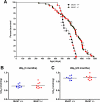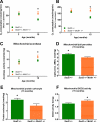Reversal of the mitochondrial phenotype and slow development of oxidative biomarkers of aging in long-lived Mclk1+/- mice
- PMID: 19478076
- PMCID: PMC2740461
- DOI: 10.1074/jbc.M109.006569
Reversal of the mitochondrial phenotype and slow development of oxidative biomarkers of aging in long-lived Mclk1+/- mice
Abstract
Although there is a consensus that mitochondrial function is somehow linked to the aging process, the exact role played by mitochondria in this process remains unresolved. The discovery that reduced activity of the mitochondrial enzyme CLK-1/MCLK1 (also known as COQ7) extends lifespan in both Caenorhabditis elegans and mice has provided a genetic model to test mitochondrial theories of aging. We have recently shown that the mitochondria of young, long-lived, Mclk1(+/-) mice are dysfunctional, exhibiting reduced energy metabolism and a substantial increase in oxidative stress. Here we demonstrate that this altered mitochondrial condition in young animals paradoxically results in an almost complete protection from the age-dependent loss of mitochondrial function as well as in a significant attenuation of the rate of development of oxidative biomarkers of aging. Moreover, we show that reduction in MCLK1 levels can also gradually prevent the deterioration of mitochondrial function and associated increase of global oxidative stress that is normally observed in Sod2(+/-) mutants. We hypothesize that the mitochondrial dysfunction observed in young Mclk1(+/-) mutants induces a physiological state that ultimately allows for their slow rate of aging. Thus, our study provides for a unique vertebrate model in which an initial alteration in a specific mitochondrial function is linked to long term beneficial effects on biomarkers of aging and, furthermore, provides for new evidence which indicates that mitochondrial oxidative stress is not causal to aging.
Figures






Similar articles
-
Lifelong protection from global cerebral ischemia and reperfusion in long-lived Mclk1(+/)(-) mutants.Exp Neurol. 2010 Jun;223(2):557-65. doi: 10.1016/j.expneurol.2010.02.002. Epub 2010 Feb 17. Exp Neurol. 2010. PMID: 20170652 Free PMC article.
-
The submitochondrial distribution of ubiquinone affects respiration in long-lived Mclk1+/- mice.J Cell Biol. 2012 Oct 15;199(2):215-24. doi: 10.1083/jcb.201203090. Epub 2012 Oct 8. J Cell Biol. 2012. PMID: 23045551 Free PMC article.
-
Early mitochondrial dysfunction in long-lived Mclk1+/- mice.J Biol Chem. 2008 Sep 19;283(38):26217-27. doi: 10.1074/jbc.M803287200. Epub 2008 Jul 17. J Biol Chem. 2008. PMID: 18635541 Free PMC article.
-
Genetic and molecular characterization of CLK-1/mCLK1, a conserved determinant of the rate of aging.Exp Gerontol. 2006 Oct;41(10):940-51. doi: 10.1016/j.exger.2006.06.041. Epub 2006 Aug 4. Exp Gerontol. 2006. PMID: 16889924 Review.
-
When a theory of aging ages badly.Cell Mol Life Sci. 2010 Jan;67(1):1-8. doi: 10.1007/s00018-009-0138-8. Cell Mol Life Sci. 2010. PMID: 19730800 Free PMC article. Review.
Cited by
-
A mild impairment of mitochondrial electron transport has sex-specific effects on lifespan and aging in mice.PLoS One. 2011;6(10):e26116. doi: 10.1371/journal.pone.0026116. Epub 2011 Oct 10. PLoS One. 2011. PMID: 22028811 Free PMC article.
-
ROS function in redox signaling and oxidative stress.Curr Biol. 2014 May 19;24(10):R453-62. doi: 10.1016/j.cub.2014.03.034. Curr Biol. 2014. PMID: 24845678 Free PMC article. Review.
-
Disruption of the mGsta4 gene increases life span of C57BL mice.J Gerontol A Biol Sci Med Sci. 2010 Jan;65(1):14-23. doi: 10.1093/gerona/glp165. Epub 2009 Oct 30. J Gerontol A Biol Sci Med Sci. 2010. PMID: 19880816 Free PMC article.
-
Epicatechin modulates stress-resistance in C. elegans via insulin/IGF-1 signaling pathway.PLoS One. 2019 Jan 28;14(1):e0199483. doi: 10.1371/journal.pone.0199483. eCollection 2019. PLoS One. 2019. PMID: 30689636 Free PMC article.
-
Co-Localization of Macrophage Inhibitory Factor and Nix in Skeletal Muscle of the Aged Male Interleukin 10 Null Mouse.J Frailty Aging. 2017;6(3):118-121. doi: 10.14283/jfa.2017.18. J Frailty Aging. 2017. PMID: 28721426 Free PMC article.
References
-
- Navarro A., Boveris A. (2007) Am. J. Physiol. Cell Physiol 292, C670–686 - PubMed
-
- Harman D. (1972) J. Am. Geriatr. Soc. 20, 145–147 - PubMed
-
- Balaban R. S., Nemoto S., Finkel T. (2005) Cell 120, 483–495 - PubMed
-
- Muller F. L., Lustgarten M. S., Jang Y., Richardson A., Van Remmen H. (2007) Free Radic. Biol. Med. 43, 477–503 - PubMed
-
- Austad S. (2008) Aging Cell 7, 119–124 - PubMed
Publication types
MeSH terms
Substances
LinkOut - more resources
Full Text Sources
Other Literature Sources
Medical
Molecular Biology Databases

